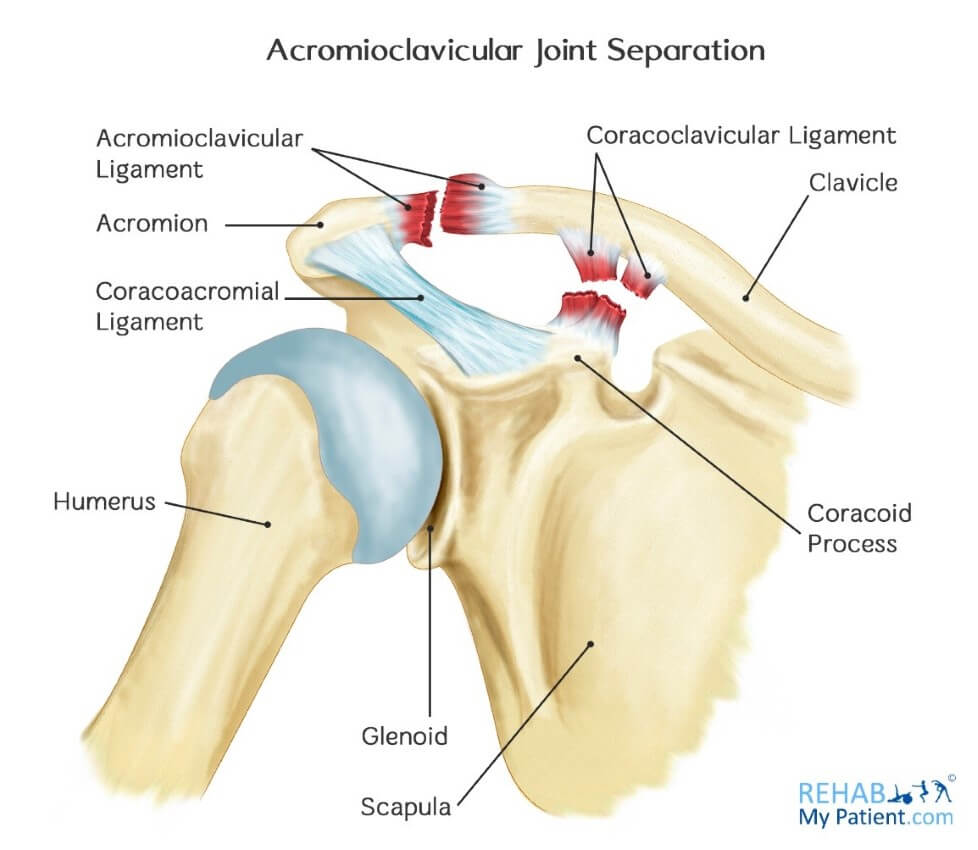Acromioclavicular Joint Separation
Opublikowano dnia 08th Oct 2016 / Opublikowano w: Ramię

The acromioclavicular joint is one of the joints that constitute the shoulder complex. It is formed by the top part of the shoulder blade (acromion) and the collar bone (clavicle). Ligaments are soft tissue structures that support the acromioclavicular joint and connect the collar bone down by attaching it to a bony bump of the shoulder blade (coracoid process).

Acromioclavicular separation occurs when trauma leads to disruption of the junction between the collar bone and the shoulder blade. The injury often occurs in high-impact contact sports players.
There is a ligament across the top of the shoulder that connects the clavicle to the acromion and is known as the acromioclavicular ligament (it’s actually comprised of two parts but you don’t need to worry too much about that). During a fall on an outstretched arm, or directly on the tip of the shoulder, the shoulder blade gets pushed downwards and the collar bone stays where it is or moves relatively upwards, resulting in a tear to the AC ligaments. The tear is graded I to VI, with I and II being sprains or partial tears. Grades III, IV, V and VI are full ruptures of the ligament.
Grade III: there has been a complete separation/dislocation of the AC joint (so the clavicle is now sitting a lot higher than the acromion). The AC ligaments and coraco-clavicular ligament has been torn.
Grade IV: there has been a complete separation/dislocation of the AC joint, and the AC ligaments, coraco-clavicular ligament, and the trapezius and deltoid muscle attachments are torn.
Grades V and VI are as above, however more severe cases.
Signs & Symptoms
- Pain (varies from mild tenderness to intense pain according to the degree of separation)
- Swelling
- Bruising
- Noticeable bump on the shoulder in advanced separation
How to manage
- Ice: Use of ice is essential and aims at reducing swelling and inflammation. Apply ice after activity for 5-10 minutes at a time, 3-5 times per day. Make sure that ice is always covered with a thin towel- do not apply ice directly on the skin. Very helpful in the first days of the injury as help minimise the swelling.
- Rest until pain decreases. This allows some time for healing process to begin.
- Physiotherapy or other manual therapy (after the acute stage). This will help mobilise the joint, reduce inflammation, and focus on strengthening exercises to stabilize the shoulder.
Do I need Shoulder Surgery?
It is not always necessary to have surgery for shoulder separation. There are different degrees of sprains and this may determine whether or not you will need to have surgery. The more severe the sprain, the more likely you are to need surgery and without it. In some cases, it is possible for this to cause further complications. However, do keep in mind that it is recommended for you to try physical therapy prior to shoulder separation surgery, as this may be successful. Often, shoulder separation surgery is used as a last resort to recovery. In cases of Grades IV, V and VI, surgery is often necessary. Sometimes people with a grade III separation will also chose to have surgery.
The risks involved with having shoulder separation surgery do not differ too much from having any other type of surgery. The benefits associated with shoulder separation surgery far outweigh any of the risks. Not only will your shoulder look the same as it once did, but it will also function normally again. These are the two main reasons that people choose to have shoulder separation surgery.
Generally, there are two different types of surgery that are used to rebuild a separated shoulder. Although there are no different names for these two types of shoulder separation surgery, you can consider them minor and significant. With minor shoulder separation surgery, the surgeon may just trim back the collarbone to prevent any friction occurring between it and the AC so that reattachment can occur. With significant shoulder separation surgery, the ligaments between the collarbone and shoulder blade can be reconstructed.
Before making the decision to have shoulder separation surgery, it is important to talk to your doctor about what options are available to you. Find out if there is anything that you can do beforehand to help restore the shoulder. If shoulder separation surgery is necessary, then it is important to find out if you will only need minor surgery or if significant surgery is the best option.
Tips
- Medication: anti-inflammatories and painkillers are usually prescribed in order to reduce inflammation and pain
- Sling: helpful for resting the joint and prevent further injury
- Avoid painful activities that aggravate pain
- Avoid overhead activities
Zapisać się
Zarejestruj się już teraz, aby skorzystać z bezpłatnego okresu próbnego!
Zacznij korzystać z Rehab My Patient już dziś i zrewolucjonizuj proces przepisywania ćwiczeń, aby zapewnić sobie skuteczną rehabilitację.
Rozpocznij 14-dniowy bezpłatny okres próbny